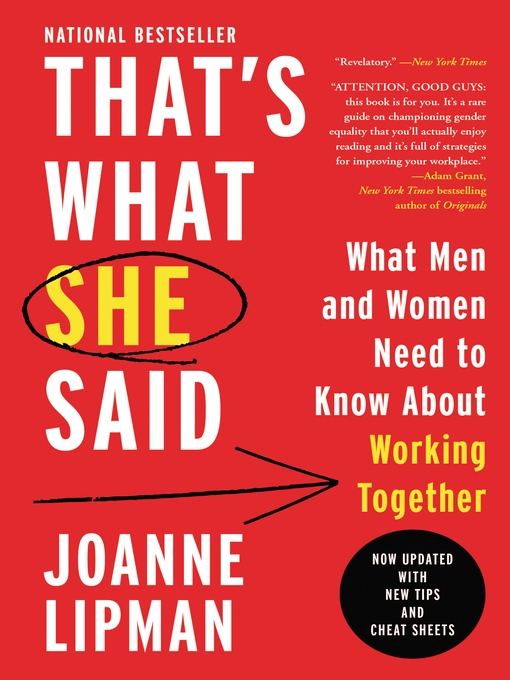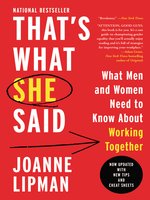-

Starred review from November 6, 2017
Lipman (Strings Attached), editor-in-chief of USA Today, makes a bold statement with this important book examining biases favoring men in business. In this road map to empowerment, Lipman explains that it’s not just men who devalue their female colleagues’ work, but also the women themselves, as perhaps most tellingly illustrated by a survey of social-psychology studies observing this phenomenon beginning in childhood. To be sure, readers will learn here of companies actively addressing gender imbalances. Lipman commends Blake Irving of GoDaddy, a company once notorious for sexist advertising, for becoming an outspoken proponent of equal pay. Elsewhere she observes that after the U.S.’s leading symphony orchestras began blind auditions, wherein auditioning musicians perform behind a screen, female representation skyrocketed, from 5% in 1970 to nearly 50% today— a tactic she finds applicable to the business world. According to one dramatic figure Lipman cites, encouraging women who gave up work for motherhood to rejoin the labor pool could add as much as $2.1 trillion to the U.S. economy. This book goes a step further than Sheryl Sandberg’s bestselling Lean In and challenges both men and women to examine their own prejudices and actively reshape work cultures to be more welcoming to women.
-

December 1, 2017
With gender pay gaps and sexual harassment increasingly in the news, books on improving the lot of women in the workplace are more relevant than ever. Lipman, chief content officer of Gannett and editor in chief of USA Today, has written this latest paean to achieving full equality. Full of solid points and extensively researched and footnoted, this book makes a point of not blaming men exclusively for the current climate. After all, as the author points out, the problems will take both men and women to solve, so alienating men is not the answer either. Implicit (as well as explicit) bias is raised, as well as issues exacerbated by women themselves, including a hesitancy to blow their own horns and seek out promotions and raises. Blind auditions are cited as one fix, but their use is limited to just a few fields. Unfortunately, much of the book feels like the author is "preaching to the choir." While well written, with timely examples and illustrations, there appears to be little that can be done to combat the problems raised without major cultural and leadership shifts. That said, getting the word out yet again, cannot hurt. VERDICT A good book on a sadly current topic. [See Prepub Alert, 8/21/17.]--Susan Hurst, Miami Univ. Libs., Oxford, OH
Copyright 2017 Library Journal, LLC Used with permission.
-

December 1, 2017
A sweeping, salient survey of the gender gap in corporate America.There are scores of bestselling books about being female in the workplace, most of which are written by women for women. Lipman (co-author: Strings Attached: One Tough Teacher and the Art of Perfection, 2013, etc.) attempts to bump the dialogue to another level by including men in the conversation. Currently the chief content officer of Gannett and editor-in-chief of USA Today, the author has long been a fixture in the upper echelons of American journalism. In this volume, she combines decades of her own observations and experiences with a profusion of data-driven research about the state of the gender union--or disunion--in the workplace. The sheer number of stories and statistics can be overwhelming at times, but they do conclusively demonstrate that inequality and sexism are alive and well in the workplace. Establishing these facts seems less about proving a point and more about getting details out of the way before moving to the main inquiry of the book--namely, how to bring about real change? Lipman chronicles numerous initiatives--many spearheaded by men--indicating that, "despite intractable issues of misogyny and abuse in some corners, we are closing in on solutions." Such programs as formal mentoring programs, blind job applications, and various educational initiatives are making a difference, though on a grand scale, the gains appear to be slight and slow. Despite the many obstacles, the book is packed with pithy insights on how real change might occur. The author notes that it will take more than just men and women reaching across the gender divide and working together; it will also require each sex to examine how they are perpetuating a workplace ideal that favors men. Impressively, Lipman manages to call out the problem and stare it squarely in the face without demonizing or alienating those who are vital to its solution.A solid start to an essential, gender-inclusive conversation.
COPYRIGHT(2017) Kirkus Reviews, ALL RIGHTS RESERVED.
-

February 1, 2018
Despite years of diversity training, mentoring, and other efforts, corporate America still suffers from a significant gender gap. Lipman, who herself worked in the then-male-dominated field as a reporter at the Wall Street Journal and who is currently editor in chief at USA Today, feels that the real solution is to get men involved in the discussion of these issues. Using wide-ranging examples, such as Google, the Harvard Business School, the Chicago Symphony Orchestra, and the nation of Icelandwhich is currently rated number one for gender equalityshe advocates that solutions will arise when more men become genuine advocates for women. She sees this already occurring with members of the millennial generation, but it still has a long way to go in the entrenched and powerful managers of her own generation. That's What She Said shows why empowering women as true equals is an essential goal for women and menand Lipman suggest pathways that can make that happen.(Reprinted with permission of Booklist, copyright 2018, American Library Association.)
-
Katie Couric
"It's great we are talking the talk but Joanne Lipman's cutting edge research and razor sharp advice will help men and women alike start walking the walk (toward a more equitable workplace)." — Katie Couric
"At last! That's What She Said is so timely—and so needed. It's the ultimate guide for women (and men) who are determined to close the gender gap. Lively and readable, it's a game-changer in how we understand gender relations—and how we can break down barriers, right now." — Sallie Krawcheck, CEO, Ellevest
"Insightful and timely. The points Joanne Lipman makes in That's What She Said are right on target for today's new workplace. It will resonate whether you're male or female, young or old, manager or managed, a long-term employee or just starting your career." — Andrew H. Tisch, Co-Chairman of the Board, and Chairman of the Executive Committee, Loews Corporation
"Attention, good guys: if you want to advocate for women but don't want to be villainized, this book is for you. It's a rare guide on championing gender equality that you'll actually enjoy reading—and it's full of strategies for improving your workplace." — Adam Grant, New York Times bestselling author of Give and Take, Originals, and Option B with Sheryl Sandberg
"Joanne Lipman leaves her soapbox at home, rolls up her sleeves, and provides real solutions to complex problems. Her valuable insights are a tool kit for men and women to not only work alongside each other but to bring out each other's best." — Glen Mazzara, Executive producer, The Shield and The Walking Dead
"That's What She Said is an instant classic. It's a must-read for two groups of people: men and women." — Roger McNamee, venture capitalist
"Lipman, editor-in-chief of USA Today, makes a bold statement with this important book examining biases favoring men in business....This book goes a step further than Sheryl Sandberg's best-selling Lean In and challenges both men and women to examine their own prejudices and actively reshape work cultures to be more welcoming to women." — Publishers Weekly (starred review)
"Revelatory." — New York Times








